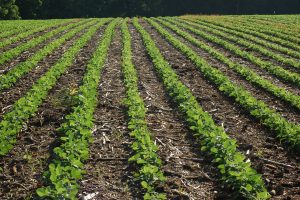See also:
Introduction

Over the last century the biggest and most sustained goal and impact of plant breeding has been increasing yields, a goal achieved to a stunning degree across most plant-based crops and foods from animals.
A number of genetic, agronomic, fertility, and pest management innovations have been required to harvest more food from the same acre. One of the as-yet unfulfilled promises of biotechnology has been increased yield. Perhaps someday this elusive goal will be attained.
One thing is certain — genetic change is only one part of a multi-leg stool (legs = genetics, soil quality, nutrient levels, water, pest pressure, farmer skill, accessible equipment, etc).
Increased plant-based yields have come about in two ways — more plants and trees per acre, and/or increasing the yield per plant or tree or vine.
In major crops like corn and soybeans, most of the yield growth over the last half-century has come from planting more seeds per acre. A variety of genetic, agronomic, and pest management changes have been required to grow three corn plants today in the square footage that one plant had all to its own in the 1950s.
Unfortunately, across the board, the incrementally rising yields of crops and animal products have been accompanied by four negative trends that have received much less attention, especially in terms of their direct relationship to yield and production levels.
1. Todays crops require more added N and other soil nutrients per bushel harvested. In short and in general, the efficiency of N use declines as yields go up.
2. Denser plantings and higher levels of N and other nutrients worsen pest pressure and increase reliance on either prevention-based IPM systems or pesticides, and often both.
This is why corn and soybean pesticide/toxin use has increased so much in recent years. So many plants (and roots) rubbing shoulders, so much N floating around, creates hyper-drive growth conditions for pests, as well as crop plants.
3. High-yield systems are much more vulnerable to significant down and up swings in yields as a result of biotic and abiotic stress, or lack thereof.
Such systems sacrifice resiliency in the pursuit of higher average yields. This increases on-farm and food system economic vulnerabilities, and is a major reason why crop insurance is now such a vital part of the ag safety net. Changes in weather patterns and atmospheric conditions due to climate change will likely compound this issue.
And the focus of this section —
4. Higher yields are generally accompanied by lower levels of several key nutrients, including protein, Vitamin C, certain minerals, and phytonutrients with antioxidant activity.

In short and in general, the grain, fruit, and vegetables harvested off high-yielding fields have more starch and other carbohydrates, and lower levels of certain vitamins, minerals, and antioxidants, compared to food harvested from lower-yielding fields. Hence, their nutritional quality, pound for pound, or bushel for bushel, has declined.
I am 6’1″ tall, have been since my late teens. Suppose my mom decided she wanted to raise a power forward in basketball, and wanted me to grow another 6″. Perhaps she would try to get me to eat more protein and calories, in the hope they would make me a few inches taller. Obviously, not a sound strategy, those extra calories go into fat, not greater height.
The same genetic, biological, and physiological realities govern what happens when farmers pour the N on a field (more plant “calories), plant more seeds per acre, or increase the energy level in animal feed.
Farmers will get more of some things, and less of others. Nature giveth and taketh.
Here on Hygeia, we will try to unravel the complex interactions between genetics, environment, agronomic practices, pest pressure and pest management systems, nutritional quality, and yields.
Some general realities are well known and accepted, like the dilution effect, and other pieces of this complex puzzle still lurk too deeply in the weeds to be evident, and accepted.
Resources
- Nutrient Decline Bibliography
- Blog- Huge Differences in Soybean Protein Content in Beans from Five Countries
- W.M. Jarrell and R.B. Beverly, “The Dilution Effect in Plant Nutrition Studies” (selected pages), Advances in Agronomy, 34, 1981.
- Davis et al., “Changes in USDA Food Composition Data for 43 Garden Crops, 1950 to 1999,” Journal of the American College of Nutrition, 2004
 Karr-Lilienthal et al., “Chemical Composition and Protein Quality Comparisons of Soybeans and Soybean Meals from Five Leading Soybean-Producing Countries,” Journal of Agriculture and Food Chemistry, 52, 2004.
Karr-Lilienthal et al., “Chemical Composition and Protein Quality Comparisons of Soybeans and Soybean Meals from Five Leading Soybean-Producing Countries,” Journal of Agriculture and Food Chemistry, 52, 2004.- Don Davis, “Trade-Offs in Agriculture and Nutrition,” Food Technology, 59:3, 2005.
- Scott et al., “Grain Composition and Amino Acid Content in Maize Cultivars Representing 80 Years of Commercial Maize Varieties,” Maydica, 51, 2006.
- Brian Halweil, “Still No Free Lunch: Nutrient levels in U.S. food supply eroded by pursuit of high yields,” The Organic Center Critical Issue Report, September 2007.
- The Organic Center, “Today’s Bumper Yields of Fruits, Vegetables and Grains Deliver Fewer Nutrients and Less Intense Flavors,” Highlights from Critical Issues Report, 2007.
- Andrew Schneider, “Taste, nutrients decline as size of crops grows,” Seattle Post-Intelligencer, September 12, 2007.
- Two NPR stories on the impact of climate change on nutrient content —
- Dan Charles, “Less Nutritious Grain May Be In Our Future,” May 8, 2014
- Merritt Kennedy, “As Carbon Dioxide Levels Rise, Major Crops Are Losing Nutrients,” June 19, 2018.

